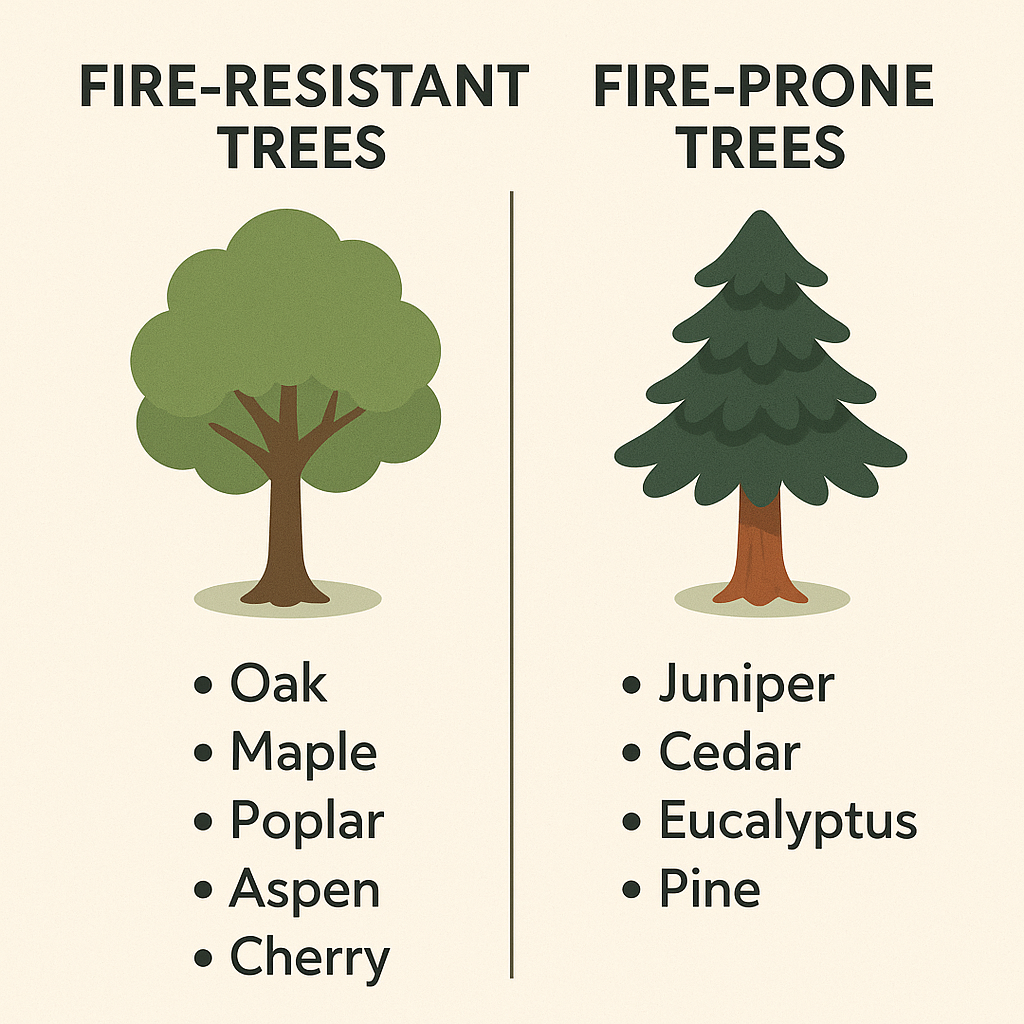Wildfires are becoming more frequent and destructive, especially in regions where drought, high winds, and dry vegetation fuel massive blazes. For homeowners living in fire-prone areas, one of the most effective defenses isn’t expensive equipment—it’s creating defensible space around your property. By making smart landscaping choices and placing trees at safe distances, you can drastically reduce wildfire risk and give firefighters a better chance to defend your home.
Understanding Defensible Space in Wildfire Safety
What Is Defensible Space?
Defensible space is the buffer zone you create between your home and the surrounding vegetation. It reduces the chance that a wildfire will reach your house, while also giving firefighters room to work.
Think of it as a shield: the goal isn’t to remove all plants, but to strategically design your landscape so it doesn’t fuel fire.
Why It Matters for Homeowners in Fire-Prone Areas
A well-maintained defensible space can be the difference between a house that survives and one that’s lost. In fact, studies show homes with proper defensible space have a much higher survival rate during wildfires.
Trees as Both a Risk and a Shield Against Wildfires
The Dual Nature of Vegetation in Fire Spread
Trees and shrubs can either spread flames quickly or slow them down. Dense, resin-rich species like junipers and eucalyptus are highly flammable, while broadleaf trees such as oaks or maples are more fire-resistant.
How Trees Can Slow Down or Redirect Flames
Well-placed trees can actually deflect wind-driven embers, block radiant heat, and prevent a fire from spreading directly to your home. The key is proper spacing and maintenance.
Safe Distances: Planting Guidelines to Reduce Wildfire Risk
The 0–5 Foot Zone: The Home Ignition Zone
-
Keep this area free of anything flammable: wood piles, mulch, or low shrubs.
-
Use gravel, stone, or hardscape materials instead of vegetation.
The 5–30 Foot Zone: The Lean, Clean, and Green Zone
-
Trees should be planted in widely spaced clusters.
-
Trim branches at least 6–10 feet above the ground.
-
Avoid ladder fuels (shrubs under trees that let fire climb upward).
The 30–100 Foot Zone: The Reduced Fuel Zone
-
Larger trees should be spaced at least 20–30 feet apart.
-
Clear dead branches, dry grass, and flammable debris.
-
Maintain driveways and access roads for firefighting vehicles.
Choosing the Right Trees for Fire-Prone Landscapes
Best Fire-Resistant Tree Species
Some trees naturally resist fire due to their high moisture content and low resin levels:
-
Oak
-
Maple
-
Poplar
-
Aspen
-
Cherry

Trees and Plants to Avoid Near Homes
Highly flammable species include:
-
Juniper
-
Cedar
-
Eucalyptus
-
Pine (dense, resin-rich species)

Tree Care and Maintenance for Wildfire Preparedness
Pruning and Trimming to Reduce Fire Ladders
Regularly cut back branches so they don’t touch the ground or your roof. Remove dead or overhanging limbs.
Cleaning Dry Leaves, Pine Needles, and Debris
Rake leaves and needles from around the base of trees and your yard. These fine fuels ignite quickly and spread fire fast.
Keeping Roofs, Gutters, and Decks Clear
Many homes ignite from embers landing on dry material. Cleaning gutters and roofs is one of the simplest yet most overlooked defenses.
How Defensible Space Saves Lives and Homes
Real-World Examples of Successful Fire Defenses
Neighborhoods with defensible space programs have seen entire streets survive wildfires, even when flames burned just yards away.
Why Every Homeowner Should Invest in Preparedness
Creating defensible space is low-cost compared to the loss of property and life. It’s an investment in safety, peace of mind, and community resilience.
Taking Action: Your Emergency Survival Guide
Why Preparedness Is a Community Responsibility
Wildfires don’t stop at property lines. When one homeowner prepares, it helps protect the entire neighborhood.
Keeping a Pocket-Size Disaster Survival Guide Handy
A portable emergency survival guide ensures your family knows evacuation routes, safety zones, and critical steps during a crisis.
👉 Learn more and keep a Disaster Survival Guide with you—it could save your life.
FAQs on Defensible Space and Wildfire Preparedness
1. What is the ideal distance to plant trees from my home?
At least 30 feet for medium trees and up to 100 feet for larger ones.
2. Are some trees naturally fire-resistant?
Yes, species like oaks, maples, and aspens are less flammable than junipers or eucalyptus.
3. How often should I trim my trees?
At least once a year before fire season, or more often if debris builds quickly.
4. Can gravel or stone landscaping help reduce fire risk?
Absolutely. Hardscaping creates a firebreak and reduces ignition sources.
5. What’s the number one cause of homes burning in wildfires?
Wind-blown embers landing on roofs, gutters, or decks.
6. Do defensible spaces guarantee my home won’t burn?
No, but they drastically improve survival chances and give firefighters a better shot at protecting your property.
Conclusion: Protecting What Matters Most
Defensible space is more than a landscaping choice—it’s a life-saving strategy. By planting the right trees, spacing them correctly, and maintaining your yard, you can transform your property into a safer, wildfire-resistant zone.
Remember: preparedness starts at home. Invest in creating defensible space today, and keep your emergency survival guide close at hand.
🔗 For more detailed preparedness resources, check out Ready.gov’s wildfire safety tips

